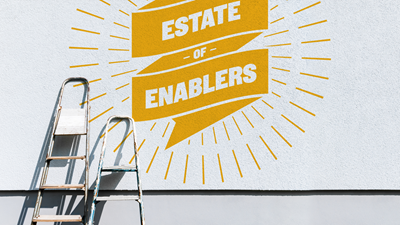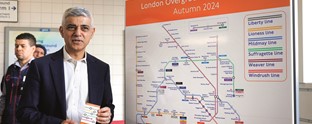Place branding: perception and reality

Establishing a place brand can help counter the negative perceptions people may have of cities, regions and countries. Amy Sandys discusses the impact a brand can have on tourism, economics, local pride and reputation
Places are precarious things. Generated over decades, centuries, millennia and more, the life of a place is contingent on the processes and people to which it is subject, its physical and social makeup impacted by the countless feet that walk its roads. And, despite their seeming longevity, places are perhaps less durable than their citizens or visitors realise. Political, economic, environmental, even social, shifts can affect all aspects of a place on any scale.
For the organisations involved in place branding, this requires the development of strategies to both adapt to, and mitigate the effect of, any negative shifts affecting place perception while turning unique place offerings into a branded entity. “What a place currently says about itself, whether a country, city or region, will be very similar to what other countries, cities or region say about themselves,” says James Byrne, growth and reputation director for brand consultancy Dragon Rouge. “It’s a question of articulating what is different and amplifying it for maximum ownability.”
The potential influence of socioeconomic shifts on cities, countries or neighbourhoods goes beyond simply affecting how successfully a destination is marketed. Sometimes, the very reputation of a place is affected by internal processes and decision making separate from the development of a place brand. The election and subsequent presidency of Donald Trump has, argues Stephen Hahn-Griffiths, executive partner and chief research officer at the Reputation Institute, led to a US divided along party political lines. This is, in turn, brewing a volatile environment in which the US place brand may struggle to thrive. Speaking about the presidential RepTrak study, carried out by the Reputation Institute on the first anniversary of Trump’s election victory, Hahn-Griffiths says, “In the run-up to the US presidential election, we called into question the ‘heir apparent’ status of Hillary Clinton and highlighted the growing momentum of Trump based on his reputation. We’ve taken a closer look at his reputation among Americans based on his credentials as commander in chief and seen an overall decline in support for the president, across all party lines and especially among men.”
This internal decline, explains Hahn-Griffiths, has the potential to generate the conditions for a negative place brand created from the inside out. “Most Americans view his overcommunication, poor executive leadership and negative persona as the leading drivers of his poor reputation among the US general public,” says Hahn-Griffiths. Corroborated by research by the Reputation Institute which indicates a perceived lack of coherence in the US government, it seems likely that the Trump presidency still has the potential to effect America’s place brand. There is no doubt external confidence in investment and governance has weakened and, given Trump’s broadly negative reputation abroad, an unwillingness to trade with a country led by a man with such controversial views.
The US place brand is arguably compromised organically, but opportunity has arisen for other US-based organisations to promote the many positive aspects of the US. Destination marketing organisation Brand USA is a tourism-driven public-private partnership concerned with promoting the country’s assets to target markets. Countering the potential for any negative impacts on visitor numbers, Brand USA helps tourists experience the diverse country as a local – which, of course, means vastly different things according to location. Speaking to meetings industry publication PCMA Convene, president and CMO of Brand USA, Christopher Thompson says, “If you look at what makes the US an aspirational destination all around the world as it relates to the diversity of the geography, the diversity of the experiences, the diversity of the people that are here to welcome our guests — none of that has changed.”
“Working to bridge the gap between external perception and internal reality is perhaps where contemporary place branding truly finds its strengths”

Regardless of socioeconomic factors, therefore, diversity is perhaps behind what makes a place, and related place brand, successful. To that end Manchester, in the UK, might be on a different latitude and even magnitude, but it enjoys a similar region-first approach.
Considered by some as the smaller, greyer alternative to London, the northwestern city of Manchester in fact has one of the biggest economies and most diverse cultural scenes in the UK. “Manchester is nothing like London,” says Jane Wentworth, owner and director of brand strategy agency Jane Wentworth Associates (JWA). “I’d call it a non-poncey cool. It’s about being a bit cheeky, a bit audacious, very entrepreneurial. It has a history that goes back centuries of being radical, left-wing; all sorts of political movers and shakers have been born out of Manchester.”
Characterised through its industrial heritage, illustrious artistic history and can-do attitude, the city of Manchester has enjoyed a resurgence in recent years. Buoyed by regeneration projects such as its historic docks and the relocation of the BBC to Salford, its economic activity and presence of four leading universities combine to attract talent and intrigue across its 12 boroughs.
Despite the underfunding challenges Manchester faces, JWA presents visitors with a city alive with opportunity, and investors something beyond the ‘Northern powerhouse’ rhetoric espoused by consecutive UK governments. “All the things that the rest of the country faces in view of the geopolitical situation is just as bad for Manchester, but it has a fantastically pragmatic attitude,” says Wentworth. “Its residents are incredibly resourceful and very proud of their city, and won’t be kept down.”
For JWA, branding Manchester through programmes such as Corridor Manchester on the city’s Oxford Road offers visitors and investors the chance to see Manchester as a collection of places, rather than just one place. Linking its industries through partnership programmes presents a ripe opportunity to brand Manchester through its grassroots credentials. “In Manchester, getting people together really makes for the possibility of doing much more,” says Wentworth. “You want to make it visible from quite far away because you want to attract inward investment. And you need to create something, really, that is visible from space.”
Yet with a focus on localisation comes the inevitable effect both of and on the community. At a hyperlocal level, the community becomes part of the place brand itself. At this scale, it’s the difference between instilling a sense of belonging for residents who may feel neglected, and allowing a maelstrom of discontent to brew until there is nothing but total despondency. The Newington estate, situated in the suburb of Ramsgate, in the parliamentary district of Thanet, UK, had struggled to shake off ill-informed and negative perceptions until it was recognised by the UK-wide Big Local funding movement as an area with potential. Big Local, which invests money into community-led regeneration projects, began a place-based initiative in Newington to empower residents to lead change. Newington estate, along with London-based brand agency Lantern, began the process of creating a unique identity to override any sense of deprivation.
And, says Ryan Tym, director at Lantern, the estate required a consolidated place brand strategy, identity and accompanying suite of marketing materials to cut through the discontent which had formed after being neglected by its surrounding institutions. Newington has an integrated community but, “A major part of the project was giving residents a sense of pride in where they were as an area, and positioning the neighbourhood as somewhere that’s defied expectations in the last couple of years,” says Tym. “We played on the idea that estates are seen as a challenging or negative place to be, but actually the residents defied that perception. And the visual language we created challenges historic notions of the estate.”
To that end, with Big Local and residential backing, Lantern created a bright and vibrant identity to reflect the personalities of the estate. A key aspect was integrating the idea of resilience, into the marketing materials and ensuring Newington residents felt their own identities were sufficiently reflected in the resulting place brand. “We looked at how best to turn the story round, how best to change the narrative from an area that’s synonymous with deprivation and a group of individuals who felt isolated by the council and previous funding opportunities,” says Tym. “It was about telling stories of what had already been done, and showing this sense of resilience of the past 50 years. Newington residents really wanted that to come through in the branding, so that’s why the language is all about the ‘United Estate of Newington,’ it’s about the estate and the neighbours. It’s about saying we are an estate, but we’re proud of that.”

And, thanks to Newington’s community-oriented spirit, a successful place brand took effect in an area perhaps previously considered to be reaping the worst effects of socioeconomic downturn. Big Local area representative for the south east of England, Carl Adams, says, “Newington Big Local wanted people to consider their community through a different lens; they were tired of being written off as an area that is down and wanted to let the world know they’re very much on the up. The people in Newington have spirit in abundance and the new brand reflects the people – bold, resilient and energised.”
Working to bridge the gap between external perception and internal reality is perhaps where contemporary place branding truly finds its strengths. For countries such as Saudi Arabia, which has long struggled with negative press surrounding its moral and ethical practices, positive change can provide a catalyst from which successful campaigns are constructed. Fresh influence on Saudi Arabia’s ruling structure has provided unprecedented impetus for change in the financially and politically dominant Middle Eastern country. The younger, more entrepreneurial outlook of the country’s crown prince, Mohammad bin Salman, has already welcomed reforms regarding women’s driving rights. Saudi Arabia has also announced a sustainability-driven initiative through the planned construction of a £500bn city in Project Neom which, spanning three countries, will run entirely on renewable energy.
“Conservative social and economic policy has hidden market opportunities from investors and brands in Saudi Arabia,” says Mariah Hartman, director of global brand consultancy Space Doctors. “As we saw with the driving decree, reform will reveal until-now hidden market potential. With an understanding of the cultural shifts and better knowledge of our consumers, we can identify the hidden opportunities for brands and their products to innovate, adapt and shape the future of the Kingdom.” Many hope that a shift in social approach will positively affect the economy, giving the green light to brands which may have previously struggled with the idea of associating themselves with the country. “The imperative to build and project Brand Saudi Arabia as a beacon to attract investors and tourists will intensify,” says Hartman. “Project Neom gives us a first glimpse into this emerging Saudi Arabia – hi-tech, sophisticated, open and optimistic. Brand Saudi Arabia will reflect and steer the popular aspirations and attitudes of the population. Brands need to align with this new emerging context for their communication.”
Saudi Arabia is a country of over 32 million, Newington an estate of a few hundred. But, regardless of scale, the implications around creating a place brand in response to, or in defence of, negative area perceptions face broadly similar challenges. “For ongoing guardianship and consistency, it’s crucial to reinforce and reference the overarching strategy every time a campaign is developed to keep the expression on-brand,” says Byrne. While place exists from the largest megaregion to the smallest hyperlocal entity, place branding requires an intuitive understanding of the process, people and decisions which shape its composition.
Branding a place is not like branding a product, Tym says. “The logo is a part of it, but for destination branding it’s about getting that change in mindset and challenging perceptions of an area. You can’t do it to the extent where you’re rewriting what an area stands for, but if somebody turns up and it doesn’t fit the reality then you’ve spoilt the place straight away.” There’s more riding on a place brand, more at stake perhaps, than a packaged product. Yet, says Byrne, if considered alongside socioeconomic context, partnerships between organisations and places can ultimately benefit any stakeholder bound up in the place brand process.
For more from Transform magazine, follow us on Twitter @Transformsays












